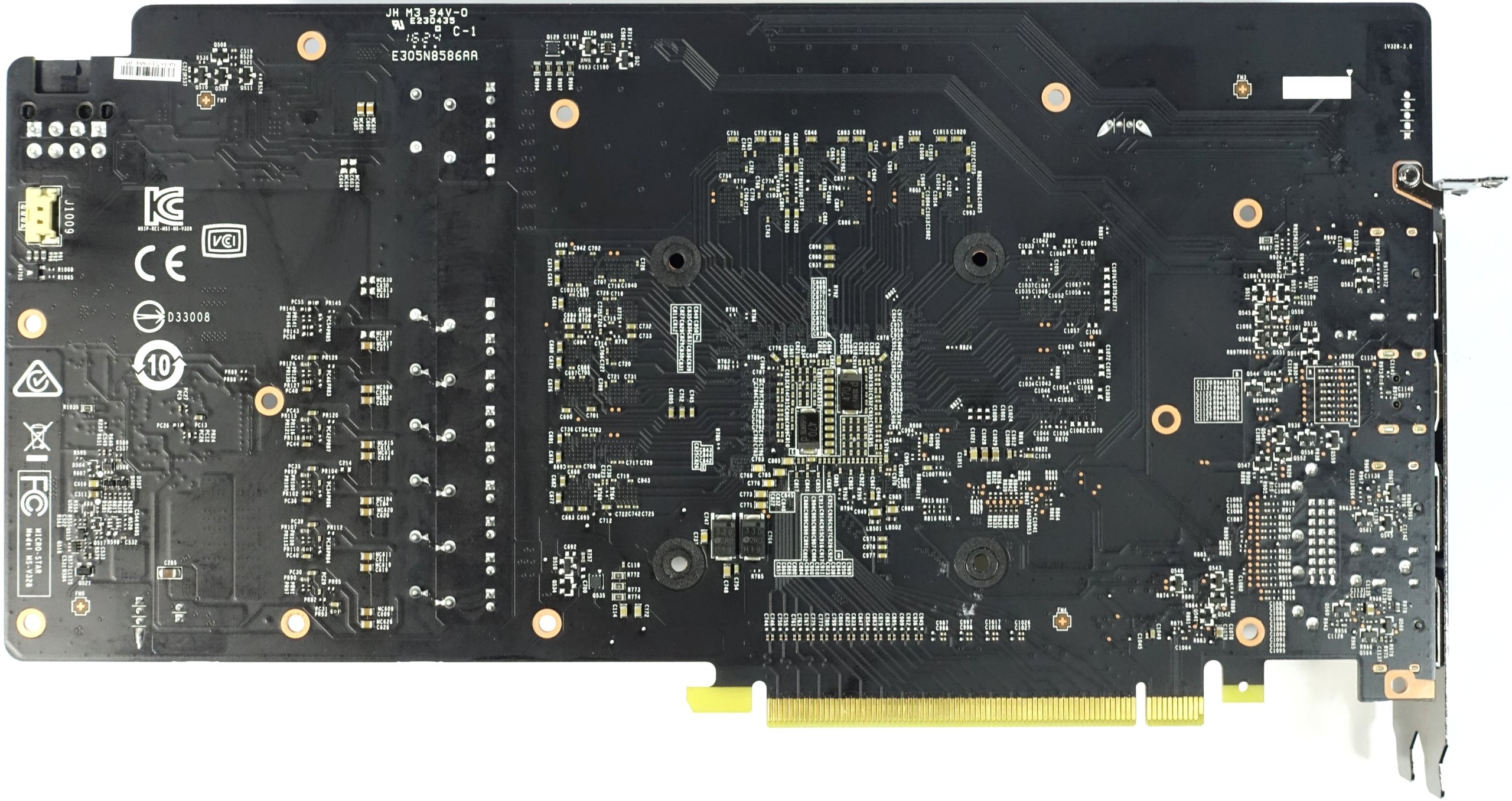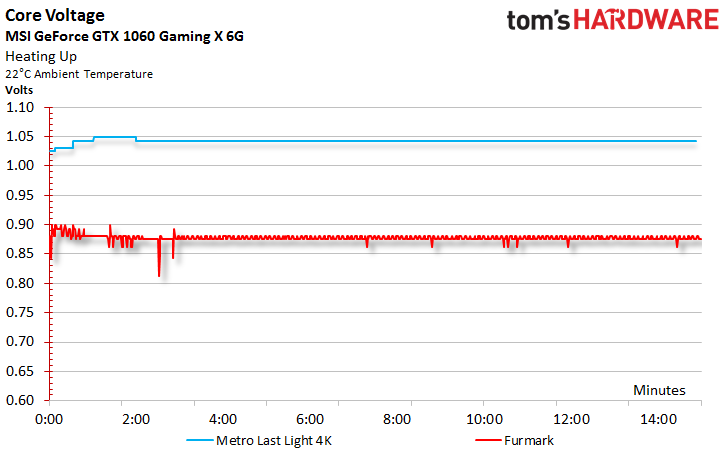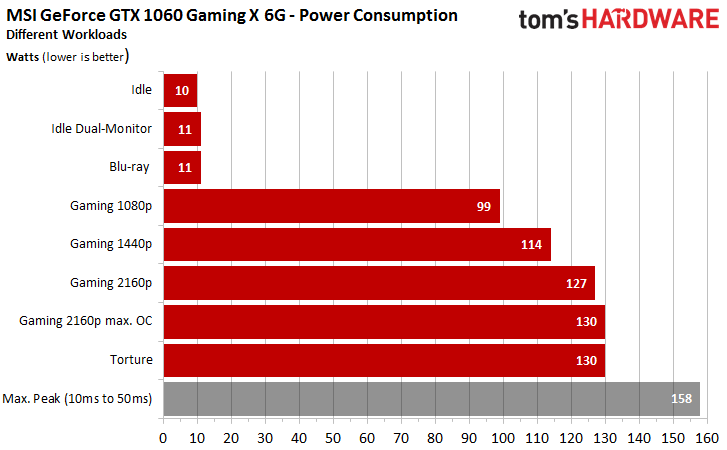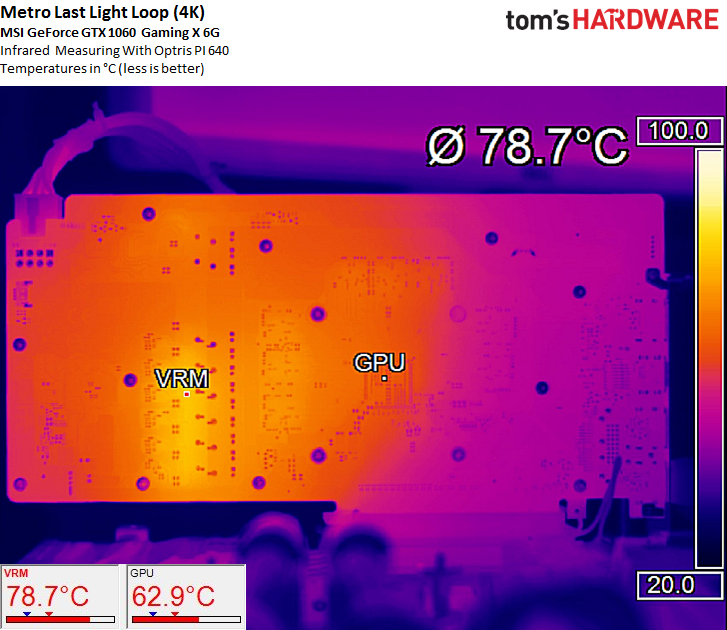Nvidia GeForce GTX 1060 Graphics Card Roundup
MSI GeForce GTX 1060 Gaming X 6G
Why you can trust Tom's Hardware
After reviewing its GeForce GTX 1080 and 1070, MSI is presenting us with a third graphics card armed with the same cooler. Naturally, on a GeForce GTX 1060, it feels a little oversized. The big thermal solution's advantage is quite obvious though; it's probably going to be even quieter than either of the two higher-end models. Otherwise, this card looks pretty similar. The most apparent difference is its lack of an SLI connector.
Even if there's not a lot about the card's appearance to introduce, our performance results are still worth going into depth on. And there's an important caveat we need to present upfront:
We test all samples as they arrive, out of the box, exactly as most gamers use them. Bundled control software or third-party tools are deliberately avoided. Once again, MSI tried to exploit this policy by delivering a so-called golden sample with a modified firmware, just as it did in the case of our GeForce GTX 1080 Gaming X 8G. The sample employs higher clock rates (and perhaps a higher power target) than the BIOS you'd receive from an off-the-shelf board.Therefore, we cannot grant this card any award, no matter how good the technical implementation may be. In addition, we also have to disqualify this card from our comparative summary; it just wouldn't be fair to the other contenders.
Technical Specifications
MORE: Best Graphics Cards
MORE: Desktop GPU Performance Hierarchy Table
MORE: All Graphics Content
Exterior & Interfaces
Similar to its higher-end relatives, this card's fan shroud is made of relatively thin plastic. Underneath, you'll find a massive frame that improves the structure's stability.
Weighing 35.4 oz (1003 grams), the GeForce GTX 1060 Gaming X 6G isn't light (it's only about 100g lighter than the GTX 1080 version). The card measures 28.4cm long, 13.5cm tall, and 3.5cm wide, monopolizing two full expansion slots and plenty of area vertically, coming off the motherboard. This is due to the large fan blades, which stretch out to a diameter of 9.5cm.


The back of the board is covered by a single-piece plate with some ventilation holes. Unfortunately, there are no thermal pads connecting it to the circuit board, so the plate does nothing to help with cooling. Because of the backplate, though, you must plan for an additional one-fifth of an inch (5mm) of clearance to avoid collisions with your CPU's cooler, particularly in small form factor cases. A lack of SLI support means you don't have to worry about fitting two GeForce GTX 1060s back to back in a case.
MSI's logo on the top of the card lights up. Again, the two 6mm heat pipes make a prominent appearance, as does an 8mm pipe. The eight-pin power connector sits on the end of the card, turned by 180°.
The black and bright red colors follow MSI's corporate design, while, again, the card's shape resembles GeForce GTX 1070 and 1080 boards in the Gaming X line-up.
The rear of the card is completely open. The cooler’s fins are positioned horizontally, directing airflow towards the slot cover and the rear. This design has the advantage that a lot of its heated air gets blown out the back of your chassis.


The slot cover sports five connectors, four of which can be used concurrently in a multi-monitor setup. There’s one dual-link DVI-D connector without an analog signal, joined by two HDMI 2.0 connectors and three DisplayPort 1.4 outputs.
Where you don't find display outputs, the rest of the bracket features openings to facilitate airflow. If MSI chose to leave off the seldom-used DVI connector, there'd be even more space for ventilation. As you may have noticed, Nvidia went that route with its recent GeForce GTX 1080 Ti announcement, bundling a DP-to-DVI dongle for those who still need the interface.
Board & Components
All five phases are powered through the auxiliary connector. The memory modules have their own phase supplied through the motherboard’s PCIe slot.
The GPU power supply’s five phases are controlled by a uP9511P made by uPI Semiconductor Corp. Dual N-channel MOSFETs in the M381 line are used for the high and low side voltage converters. This setup eliminates the need for separate gate drivers, which saves both space and money.
The memory’s single phase has one small uP1641P also supplied by uPI Semiconductor Corp. It’s joined by a different voltage converter, the SM7320, which is also a dual N-channel MOSFET.
MSI uses the same coils we've seen for years. Their quality is just what you’d expect from a mass-market product in this category with decent encapsulation. That's to say they're better than Foxconn’s Magic coils.
Two capacitors are added right below the GPU to smooth out voltage peaks. This design is similar to Nvidia's reference implementation.
Only six of the eight available memory emplacements are populated with Samsung K4G41325FC-HC25 modules (32x 128 Mb). Their voltages range between 1.305 and 1.597V, depending on clock rate. Altogether, this amounts to just 3GB of graphics memory.
Power Results
Before addressing power consumption directly, let's take a look at the relationship between clock rate and voltage. In the case of MSI's GeForce GTX 1060 Gaming X 6G, this illustrates that frequency doesn't drop significantly during gaming, even after an imposed warm-up period.
Our observed GPU Boost rate falls from 2000 MHz to a still-respectable 1974 MHz over time and under load. The curve's slope is mirrored in our voltage readings. A 1.05V starting point pulls back ever-so-slightly to 1.043V by the end of our run.
The lowest GPU clock rate measured at idle is about 240 MHz.
We took our measurements using a variable low-pass filter, so we mention short load peaks only as a side note (see the grayed-out bar in the chart below), since those peaks are rarely relevant in practice.
Power Connector Load
Since MSI's GeForce GTX 1060 Gaming X 6G doesn't use the motherboard slot's 3.3V rail, we left it out of our chart.
The power distribution we observe shows a heavy bias toward the auxiliary power connector, which supplies just under 100W.
Here's the data for the gaming and stress tests:
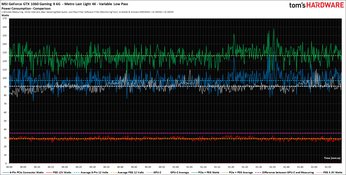

Power consumption on its own only tells us part of the story. The PCI-SIG specifies a maximum of 5.5A at the motherboard slot, and we're showing a reading under 3A, which puts MSI's GeForce GTX 1060 Gaming X 6G in the green.
Of course, we have the data for measured currents as well:
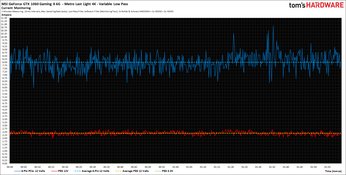

The Cooler & Its Performance
Behind every successful high-performance graphics card is a well-designed cooler. In this case, MSI's implementation is pretty elaborate given the GP106 GPU's thermal ceiling. In contrast to MSI's GeForce GTX 1070 and 1080 Gaming X boards, the 1060 Gaming X relies on a closed frame that not only keeps the board nice and stable, but also helps cool the memory modules and VRMs.
Thermal pads provide the bridge necessary to transfer heat from the memory and power circuitry, though we would have preferred a thinner and more efficient design. After all, MSI uses low fan speeds that don't move much air.
The frame is screwed to the backplate, and ~3mm-tall spacers allow some air to flow between the plate and PCB.
As mentioned, this cooler is almost identical to the one used on the GTX 1070 and 1080 Gaming cards. It uses the same horizontally-oriented fins and heat pipe configuration. The direction they face is more or less irrelevant, since they're made of sintered composite material.
A massive nickel-plated sink takes the heat from those pipes and dissipates it out through aluminum fins.
The cooler does its job almost inaudibly. And yet it performs incredibly well, enabling readings around 145°F (63°C) during our gaming loop, and topping out at 149°F (65°C) in a closed case.
Our measurements with the backplate and stabilizing frame removed show that MSI won't let this card go up in flames. The gaming loop and stress test fail to turn up any apparent issues.
It becomes clear during our gaming test sequence that the lower five voltage regulator phases handle most of the load, while the memory's VRM remains fairly cool thanks to its less demanding task.
In the end, MSI's cooling solution does a great job (as it should, since it was designed for loads almost 100 percent higher).
Sound Results
Thanks to an exemplary implementation of hysteresis and fan speeds around 800 RPM, this card is almost inaudible.
When the GeForce GTX 1060 Gaming X 6G is idle, its noise is not measurable due to a semi-passive mode. Thus, we abstained from taking those readings.
Since this card's fans are the same ones used to cool MSI's GeForce GTX 1070/1080 Gaming boards (meaning they're almost overkill), our test chamber remains frighteningly quiet. An excellent 29.3 dB(A) result drops below the threshold of minimal background noise for a room inside a quiet apartment.
All we found were minimal vibrations in the low-frequency range caused by the slow-spinning fan motors. That's basically nit-picking though, since these vibrations aren't audible.
MSI GeForce GTX 1060 Gaming X 6G
Reasons to buy
Reasons to avoid

MORE: Nvidia GeForce GTX 1080 Roundup
MORE: Nvidia GeForce GTX 1070 Roundup
MORE: All Graphics Content
Current page: MSI GeForce GTX 1060 Gaming X 6G
Prev Page MSI GeForce GTX 1060 Gaming X 3G Next Page Palit GeForce GTX 1060 Super JetStreamGet Tom's Hardware's best news and in-depth reviews, straight to your inbox.

Igor Wallossek wrote a wide variety of hardware articles for Tom's Hardware, with a strong focus on technical analysis and in-depth reviews. His contributions have spanned a broad spectrum of PC components, including GPUs, CPUs, workstations, and PC builds. His insightful articles provide readers with detailed knowledge to make informed decisions in the ever-evolving tech landscape
-
Achaios @Igor: I really appreciate your articles. I have one small request: PLEASE consider adding benchmarks results from 3D MARK FIRESTRIKE so that we can compare your results with our GPU's. Really appreciated your "Das große Radeon RX480 Test-Roundup - Teil 1" too, though again, there are no 3D MARK FIRESTRIKE results.Reply -
bloodroses Darnit, the Zotac and Gigabyte mini models weren't covered. I was curious to see how those two compare vs. the EVGA model since I'm working with limited space inside my case.Reply -
agent88 I bought a retail MSI Geforce GTX 1060 Gaming X card last month and it was defaulted to OC mode by default. This is the same as the test version that the press received. Wondering if MSI is shipping this version to all consumers now or if I just got lucky with a "golden sample". Also, MSI provides both the MSI gaming app and afterburner software. The gaming app offers 1-click option to choose the OC mode. AReply -
shrapnel_indie Good to see a roundup... However, I think the 3GB and the 6GB belong in the same category as much as the RX-470 and RX-480 do. That is: they don't.Reply -
FritzEiv We're working on getting more cards in for all categories (1080, 1070, 1060), including from Asus, which is working on getting us cards. In fact, we'll have an update to our 1070 roundup shortly (2 new cards). And we're working on a 480 roundup as well.Reply -
mikeangs2004 Reply19457023 said:Darnit, the Zotac and Gigabyte mini models weren't covered. I was curious to see how those two compare vs. the EVGA model since I'm working with limited space inside my case.
they are kind of for the niche market just like in the days of low profile units -
Ancient1 Regarding the EVGA GTX 1060 SC :Reply
Could someone who disassemble it post the measurements ( WxHxL ) of the HEATPIPE ?? I plan on carving a Copper Heatsink, rather than Thermal Pads.
I am also thinking about HS for the memory etc , along the Pipe. But it will impact AirFlow and might degrade the HeatPipe efficiency as , to my knowledge, Heatpipe depends on temperature difference between the cooled GPU and the Heat Expelling (to the fins) areas of it.
Please post, Google will find it :)
Thanks in advance



